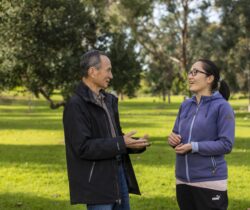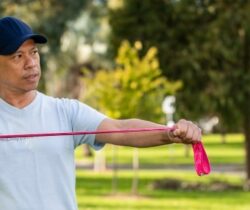Participating in a healthy lifestyle program can be life changing, particularly if it’s one that addresses every aspect of health – physical, mental and emotional.
Physical health is about how our bodies feel and how well they function. Mental health relates to how we think, and emotional health concerns how we manage our emotions as we go through our daily lives.
Healthy lifestyle programs usually support people to make changes to the way they live. Their purpose is to assist the prevention, treatment and management of disease – often, chronic conditions such as diabetes, heart disease and cancer. They focus on replacing lifestyle risk factors for those conditions with healthy habits.
In this article, we will look at what those healthy habits are and how you can integrate them into your life. We’ll also introduce you to Life!, a free healthy lifestyle program that has helped thousands of people live a healthier life.
The Foundation: Nutrition and Diet
Eating a nutritious, balanced diet is important for maintaining good health and reducing the risk of chronic disease.
A well-balanced diet gives us the nutrients that we need. These can be categorised as:
Macronutrients:
- carbohydrates, which store and provide energy
- proteins, which are essential for the growth, repair and maintenance of body tissue
- fats, which are important for energy storage and cell function.
Micronutrients:
- vitamins, which support bodily processes
- minerals, which are essential for bone health and nerve function
Water, which is necessary for hydration and digestion.
To achieve a healthy balance of nutrients, the Australian Dietary Guidelines recommend eating a variety of foods in moderation from the following five groups:
- vegetables and legumes/beans
- fruit
- grain and cereal foods
- lean meat and poultry, fish, eggs, tofu, nuts, seeds and legumes
- milk, yoghurt, cheese and/or alternatives
A healthy, well-balanced diet provides you with the energy you need to stay active.
Movement Matters: Exercise and Fitness
Regular exercise is an essential part of a healthy lifestyle, and it can reduce your risk of chronic diseases. Exercise combats the effects of a sedentary lifestyle and offers benefits that include improvements to:
- heart health
- bone density
- weight management
- insulin efficiency, which helps in the management of blood glucose levels
- overall fitness and resilience
- posture
- injury prevention
The emotional health benefits of exercise include a greater ability to manage stress and improved self-esteem.
The main categories of exercise include:
- Aerobic exercise (cardio) – this increases your heart rate and breathing, improving cardiovascular (heart health). It lowers blood pressure, burns body fat and boosts your mood. Examples of aerobic exercise are brisk walking, swimming and cycling.
- Strength training (resistance exercise) – this builds muscle mass and stimulates bone growth. As well as increasing strength, it improves balance and posture. Examples are weightlifting, bodyweight exercises and resistance band work.
- Flexibility exercises (stretching) – these improve joint and muscle flexibility, enhancing your overall mobility. Examples include static stretches (holding a position) and dynamic stretches (moving while stretching).
- Balance exercises – these enhance stability and improve coordination and posture. Examples include yoga and tai chi movements and specific balance routines.
According to the Department of Health and Aged Care, each week adults should do:
- 2.5 to 5 hours of moderate-intensity physical activity such as brisk walking, mowing the lawn or swimming, or
- 1.25 to 2.5 hours of vigorous-intensity physical activity such as fast cycling, soccer or netball, or
- an equivalent combination of moderate and vigorous activities
Strength training activities should be included on at least two days each week.
Rest and Recovery: The Importance of Sleep
Sleep is a key part of a healthy lifestyle. The Sleep Health Foundation recommends that adults should aim for between seven and nine hours of sleep per night. Not getting enough sleep can cause impaired judgement and poor physical coordination, which increases the risk of accidents and injury. Long-term lack of sleep is associated with an increased risk of diabetes and obesity.
There are ‘sleep hygiene’ habits that can positively affect the quality and the quantity of your rest.
These include:
- maintaining a consistent sleep schedule by going to bed and getting up at the same time every day
- creating a relaxing bedtime routine – do calming activities such as reading or following relaxation techniques
- optimising your sleeping environment – keep your bedroom dark, quiet and cool
- avoiding big meals, caffeine and alcohol late in the evening
- exercising regularly and maintaining a healthy diet
- managing stress and anxiety
Prioritising a good night’s sleep will improve your overall health and wellbeing.
Stress Management: Building your Resilience
Stress is the body’s reaction to feeling threatened. When we’re stressed, our body releases adrenaline, which motivates us to act quickly.
Long-term stress can have the the following impacts on the body:
- raised blood pressure and increased risk of heart attack and stroke
- impaired insulin effectiveness, potentially leading to type 2 diabetes
- gastrointestinal problems
- chronic muscle tension
In terms of mental and emotional health, stress can lead to:
- anxiety
- depression
- cognitive impairment, which may affect memory, concentration and decision making
There are many strategies for managing stress.
These include:
- practising relaxation techniques or meditation
- eating a healthy diet
- doing the recommended amount of exercise
- getting enough sleep
- creating a balanced lifestyle that includes time for hobbies and relaxation
Mind-Body Connection: Holistic Health Practices
The holistic health approach considers a person’s wellbeing to be made up of physical, mental and emotional aspects. Two holistic practices that can significantly strengthen the connection between them are mindfulness and meditation:
Mindfulness
Mindfulness encourages you to focus your entire attention on the current moment. Becoming aware of the thoughts, feelings and physical sensations that are present now deepens the connection between the mind and body. The practice of mindful eating involves focusing on the flavours, textures and smells of food. Eating more deliberately can aid digestion and the absorption of nutrients. Mindful eating can make you more alert to the physical sensations of being full, which can help prevent overeating and thus support weight management.
Meditation
In meditation, you focus your attention on an object or thought, which helps to create a state of calm clarity. Meditation can make you more aware of physical sensations (such as that of being full). Guided meditations are available on phone apps and YouTube, and include exercises like deep breathing or focusing on your surroundings during activities such as taking a walk in the park.
For more information on mindfulness and meditation, including tips for getting started, see here
Please speak to your doctor before starting any complimentary medicine or treatment.
Creating Sustainable Habits: Behaviour Change Strategies
Even when you know exactly what to do, it can be hard to make lasting healthy lifestyle changes. Helpfully, there are reliable strategies for setting realistic goals, creating long-lasting healthy habits and maintaining motivation.
The SMART formula is effective for setting goals. SMART stands for:
- Specific – goals should be clear and well defined
- Measurable – they should include a way of tracking progress
- Achievable – realistic goals help you avoid setting yourself up for failure
- Relevant – goals should be relevant to what you want to achieve
- Time bound – goals should have a clearly defined timeline (which helps with motivation)
For more information on setting goals, see here.
Once you’ve started working towards your goals, monitoring your progress will help keep you motivated and flag any need for adjustments. Having support systems and an ‘accountability partner’ (someone who supports another person to maintain progress towards a goal) can also be beneficial.
A great technique for creating sustainable change is ‘habit stacking’. This is where you link new habits to existing ones. For example, you might decide to list three things you’re grateful for while drinking your morning coffee. Or you might do five push-ups every time you brush your teeth
The Life! program can help.
Taking action to create a healthier lifestyle can be empowering and beneficial and it’s essential to have the right kind of support.
The Life! program is a free lifestyle modification program that covers topics such as nutrition, physical activity, general wellbeing, stress management and sleep hygiene. Run by expert health professionals, it is delivered as a group course or telephone health coaching service. The program helps eligible Victorians to make small changes to their lifestyle so that they can achieve their health goals and reduce their risk of type 2 diabetes, heart disease and stroke.
Life! is funded by the Victorian Government and managed by Diabetes Victoria.
Since 2007, Life! has helped more than 75,000 Victorians live a healthier life.
It has been demonstrated that the program improves:
- participants’ lifestyle, including diet, physical activity levels and sitting behaviours
- their physical outcomes, including reducing their weight and waist circumference
- their ability to meet their healthy eating and physical activity goals
Check your eligibility for the Life! program by taking a quick online test here.





